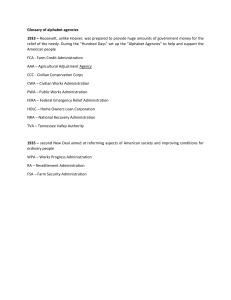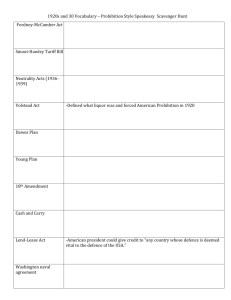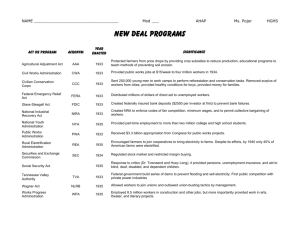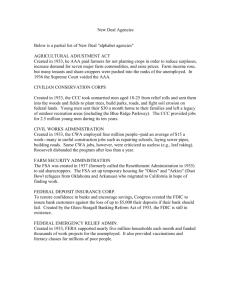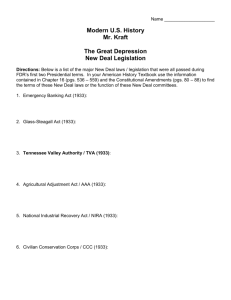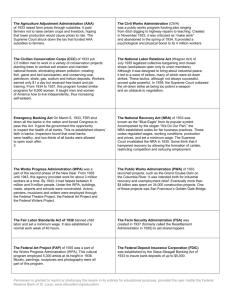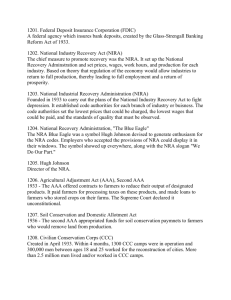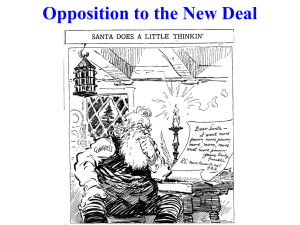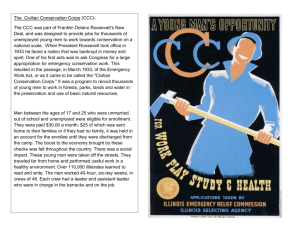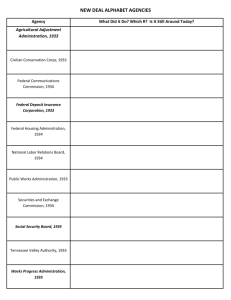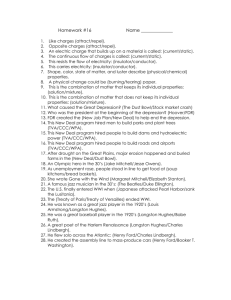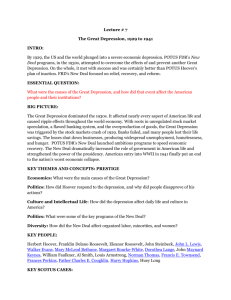New Deal Agencies Gallery Walk
advertisement
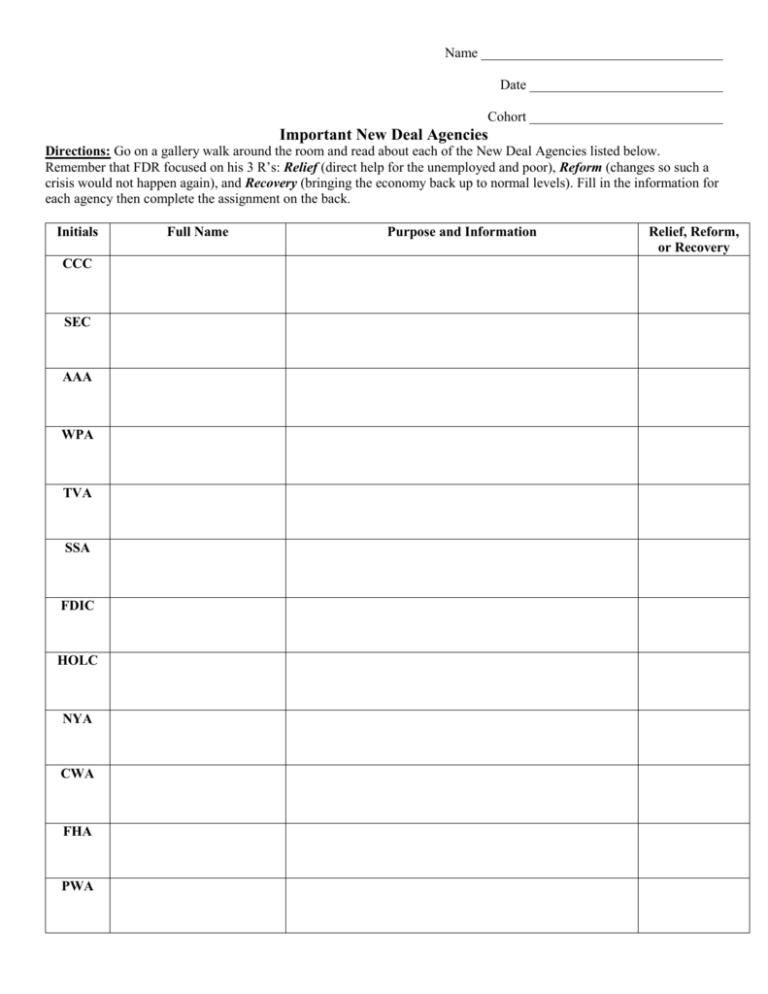
Name ___________________________________ Date ____________________________ Cohort ____________________________ Important New Deal Agencies Directions: Go on a gallery walk around the room and read about each of the New Deal Agencies listed below. Remember that FDR focused on his 3 R’s: Relief (direct help for the unemployed and poor), Reform (changes so such a crisis would not happen again), and Recovery (bringing the economy back up to normal levels). Fill in the information for each agency then complete the assignment on the back. Initials CCC SEC AAA WPA TVA SSA FDIC HOLC NYA CWA FHA PWA Full Name Purpose and Information Relief, Reform, or Recovery Directions: After completing the chart of the New Deal Agencies on the opposite side, create your own illustration that either SUPPORTS or CRITICIZES one of the agencies from your chart. Use the rest of the space below to create this; I should be able to easily identify your choice and stance on the agency. Securities and Exchange Commission The Securities Act of 1933 required public corporations to register their stock sales and distribution and make regular financial disclosures. The Securities Exchange Act of 1934 created the SEC to regulate exchanges, brokers, and over-the-counter markets, as well as to monitor the required financial disclosures. The SEC was authorized to break up any unnecessarily large utility combinations into smaller, geographically based companies and to set up federal commissions to regulate utility rates and financial practices. Works Progress Administration In April 1935, the WPA was established under the Emergency Relief Appropriation Act, as a means of creating government jobs for some of the nation's many unemployed. It employed more than 8.5 million persons on 1.4 million public projects before it was disbanded in 1943. The program chose work that would not interfere with private enterprise, especially vast public building projects like the construction of highways, bridges, and dams. However, the WPA also provided federal funding for students, who were given work under the National Youth Administration. Civilian Conservation Corps Formed in March 1933, the Civilian Conservation Corps, CCC, was one of the first New Deal programs. It was a public works project intended to promote environmental conservation and to build good citizens through vigorous, disciplined outdoor labor and was operated under the army’s control. Camp commanders had disciplinary powers and corpsmen were required to address superiors as “sir.” By September 1935 over 500,000 young men had lived in CCC camps, most staying from six months to a year. The work focused on soil conservation and reforestation. Most important, the men planted millions of trees on land made barren from fires, natural erosion, or lumbering—in fact, the CCC was responsible for over half the reforestation, public and private, done in the nation’s history. Corpsmen also dug canals and ditches, built over thirty thousand wildlife shelters, stocked rivers and lakes with nearly a billion fish, restored historic battlefields, and cleared beaches and campgrounds. Agricultural Adjustment Administration One of the first programs of the New Deal to be introduced and enacted was the Agricultural Adjustment Act. The intent of the AAA was to restore the purchasing power of American farmers to pre-World War I levels. The money to pay the farmers for cutting back production by about 30 percent was raised by a tax on companies that bought farm products and processed them into food and clothing. The AAA evened the balance of supply and demand for farm commodities so that prices would support a decent purchasing power for farmers. This concept was known as "parity." AAA controlled the supply of seven "basic crops" — corn, wheat, cotton, rice, peanuts, tobacco, and milk — by offering payments to farmers in return for farmers not planting those crops. The AAA also became involved in assisting farmers ruined by the advent of the Dust Bowl in 1934. Tennessee Valley Authority On May 18, 1933, President Roosevelt signed the Tennessee Valley Authority Act, as part of the flurry of legislation that marked Roosevelt`s first 100 days in office. The TVA pledged to improve navigability on the Tennessee River, as well as provide flood control, reforest and improve marginal farm land, assist in industrial and agricultural development, and assist in the creation of a government nitrate and phosphorus manufacturing facility. The TVA was one of the most ambitious projects of the New Deal in its overall conception. The TVA encountered many setbacks and failures and was involved in many controversies, but it brought electricity to thousands of people at an affordable price. It controlled the flood waters of the Tennessee River and improved navigation, as well as introduced modern agriculture techniques. Social Security Administration Signed on August 14, 1935, President Roosevelt became the first president to advocate federal assistance for the elderly. The Act provided benefits to retirees and the unemployed, and a lump-sum benefit at death. Payments to current retirees are financed by a payroll tax on current workers' wages, half directly as a payroll tax and half paid by the employer. The act also gave money to states to provide assistance to aged individuals, for unemployment insurance, aid to families with dependent children, maternal and child welfare, public health services, and the blind. Federal Deposit Insurance Corporation This independent U.S. government corporation created under authority of the Banking Act of 1933, with the responsibility to insure bank deposits in eligible banks against loss in the event of a bank failure and to regulate certain banking practices. It was established after the collapse of many American banks during the initial years of the Great Depression. Although earlier state-sponsored plans to insure depositors had not succeeded, the FDIC became a permanent government agency through the Banking Act of 1935. The FDIC’s income is derived from assessments on insured banks and from investments. Insured banks are assessed on the basis of their average deposits. The corporation is authorized to insure bank deposits in eligible banks up to a specified maximum amount that has been adjusted through the years having begun in 1934 with deposit insurance of $5,000 per account. From 1933, all members of the Federal Reserve System were required to insure their deposits, while nonmember banks—about half the United States total— were allowed to do so if they met FDIC standards. Home Owners Loan Corporations This New Deal agency was established in 1933 by the Home Owners' Loan Corporation Act under President Franklin D. Roosevelt. Its purpose was to refinance home mortgages currently in default to prevent foreclosure. This was accomplished by selling bonds to lenders in exchange for the home mortgages. It was used to extend loans from shorter loans to fully amortized, longer term loans (typically 20-25 years). Through its work it granted long term mortgages to over a million people facing the loss of their homes. The HOLC stopped lending circa 1935, once all the available capital had been spent. HOLC was only applicable to nonfarm homes, worth less than $20,000. HOLC also assisted mortgage lenders by refinancing problematic loans and increasing the institutions liquidity. National Youth Administration As a New Deal organization the National Youth Administration (NYA) was established within the Works Progress Administration (WPA) on June 26, 1935, and funded by the Emergency Relief Appropriation Act of 1935. NYA provided work training based on U.S. citizenship and financial need for youth between ages sixteen and twenty-five. In addition to offering courses in writing, reading, and arithmetic, NYA operated two programs: the Works Project Program to train unemployed, out-of-school youth, and the Student Aid Program to provide workstudy training for high school, college, and graduate students. Congress distributed federal money each academic year to state educational institutions for scholarships and grants. The projects gave rise to learning skills in road and building construction, woodworking, office work, nursing, furniture and auto repair, radio operation, landscaping, blacksmithing, welding, agriculture, and domestic science. The national WPA regulated work hours at eight hours a day, forty hours a week, and seventy hours a month. Earnings ranged from ten to twenty-five dollars per month, which often went to the worker's family. NYA offered self-improvement, health benefits, citizenship courses, and vocational guidance. It also provided social opportunities through community youth centers featuring athletics, hobby clubs, dramatics, games, music, and dancing. Civil Works Administration Created on November 9, 1933, the CWA was to hire workers to assist in the creation of public projects. This program hired both men and women. The State Relief Commission directed the CWA's efforts in Ohio. The CWA's projects focused on the repair or construction of public buildings, roadways, and parks. The CWA began more than six thousand projects in Ohio alone. By January 1934, the Civil Works Administration had provided employment to more than four million Americans, including over 200,000 Ohioans. During its existence, the CWA paid approximately forty-nine thousand dollars in wages to Ohioans, helping them to meet their needs during the Great Depression. Unskilled workers received fifty cents per hour, while skilled workers were paid $1.20 per hour. The Civil Works Administration remained in operation until March 1934, when the federal government terminated the program due to its tremendous costs. Federal Housing Administration The FHA is a government agency, established by the National Housing Act of 1934, to regulate interest rates and mortgage terms after the banking crisis of the 1930s. Through the newly created FHA, the federal government began to insure mortgages issued by qualified lenders, providing mortgage lenders protection from default. If a borrower failed to make their payments, the FHA was required to cover the unpaid balance. The government-insured mortgages provided stability to the housing market and increased the availability of funding for home building and purchasing. The FHA adjusted several aspects of the housing finance system, such as increasing the maximum allowable mortgage, which made ownership widely available to many Americans. In order to obtain a mortgage, however, the FHA required that the mortgage, property, and borrower meet certain requirements, some of which led to the perpetuation of racial discrimination and urban disinvestment. Public Works Administration Created by the National Industrial Recovery Act on June 16, 1933, the PWA budgeted several billion dollars to be spent on the construction of public works as a means of providing employment, stabilizing purchasing power, improving public welfare, and contributing to a revival of American industry. Simply put, it was designed to spend "big bucks on big projects." Between July 1933 and March 1939, the PWA funded the construction of more than 34,000 projects, including airports, electricity-generating dams, and aircraft carriers; and seventy percent of the new schools and one third of the hospitals built during that time. It also electrified the Pennsylvania Railroad between New York and Washington, D.C. Its one big failure was in quality, affordable housing, building only 25,000 units in four and one half years. The PWA spent over $6 billion, but did not succeed in returning the level of industrial activity to pre-depression levels. Nor did it significantly reduce the unemployment level or help jump-start a widespread creation of small businesses. Nonetheless, the historical legacy of the PWA is perhaps as important as its practical accomplishments at the time. It provided the federal government with its first systematic network for the distribution of funds to localities, ensured that conservation would remain an element in the national discussion, and provided federal administrators with a broad amount of badly needed experience in public policy planning.
